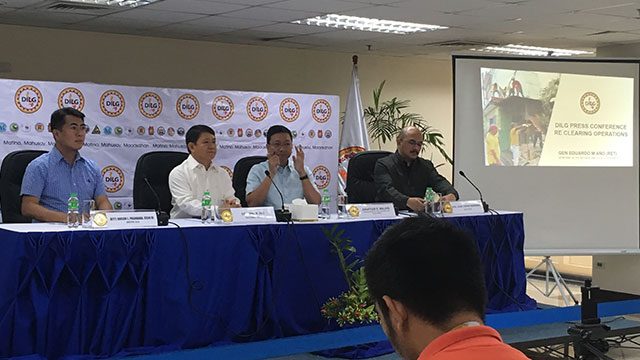SUMMARY
This is AI generated summarization, which may have errors. For context, always refer to the full article.

MANILA, Philippines – A little past the halfway mark of the 60-day period for the nationwide road clearing operations, the Department of the Interior and Local Government (DILG) hailed Metro Manila as the top-performing region.
DILG Secretary Eduardo Año said on Tuesday, September 3, he was satisfied with the performance of Metro Manila mayors. All 17 local government units (LGUs) were compliant with the directive to complete road inventories and conducting clearing operations.
Following President Rodrigo Duterte’s order during his 2019 State of the Nation Address, the department issued a directive last July 29 for LGUs across the country to reclaim public roads to address the worsening traffic situation, especially in the National Capital Region.
Here are the highlights of DILG’s report in numbers.
Cleared obstructions in Metro Manila
| 139,959 | meters of roads cleared |
| 52,831 | meters of sidewalks cleared |
A week ago, Metro Manila mayors reported their progress to the Metropolitan Manila Development Authority, with a few of them already having 100% completion rates for clearing major and secondary roads as well as Mabuhay lanes.
Some mayors faced complex decisions in clearing obstructions, such as returning obstructions and structures with historical significance. (READ: NCR mayors tackle challenges halfway through 60-day road clearing)
LGU compliance rates by region
| 100% | in Metro Manila |
| 77.5% | in Cagayan Valley |
| 62.3% | in Central Luzon |
| 58.3% | in Central Visayas |
| 53.5% | in Calabarzon |
| 52.6% | in Western Visayas |
Next to Metro Manila, Cagayan Valley and Central Luzon are the regions most compliant with the road clearing directive so far.
As the September 29 deadline to complete road clearing operations nears, Año said the department will be on the look out for LGUs with “red flags” or those who are still far from completing the mandate.
He said 43.3% or less than half of all LGUs nationwide have conducted road clearing operations.
Displacement
| 1,444 | vendors |
| 1,292 | illegally parked vehicles |
| 813 | miscellaneous obstructions (booths, monoblocks, etc.) |
| 49 | terminals |
Metro Manila mayors are addressing cases of displacement in their city through utilizing idle lands and unused government buildings. They have relocated vendors to available spaces in public markets, and have come up with creative solutions, such as a free terminal in a mall parking lot.
During the Tuesday press conference on the midway assessment, Año urged local officials to implement rehabilitation programs for those displaced by the clearing operations to allow them to legally continue their business.
Local ordinances related to road clearing
| 707 or 43.3% | conducted road clearing operations |
| 397 | enacted or revisited their local ordinances relevant to clearing and banning obstructions |
| 983 | completed road inventories |
| 668 | have displacement strategies for affected citizens |
| 609 | have rehabilitation efforts for recovered public roads |
- The memorandum circular issued in July specifically ordered local government officials to:
- Reclaim public roads and rid them of illegal structures.
- Rehabilitate recovered public roads, for example by placing street names and street lights.
- Develop and implement strategies to address displacement.
While 1,444 illegal vendors have been displaced by operations, it remains to be seen how many of them belong to LGUs which have put in place strategies to relocate them.
The memo also stated that local councils are to revisit ordinances to ensure responsiveness and consistency with the presidential directive. Provinces, highly-urbanized cities, other cities, and municipalities must also provide an inventory of all roads within their jurisdiction. – Rappler.com
Add a comment
How does this make you feel?
There are no comments yet. Add your comment to start the conversation.